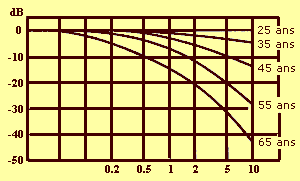Hearing

It’s one of our 5 senses, the one that allows us to perceive sounds. Most of your readers are musicians, but I’m sure you don’t really know all the characteristics of our auditory system. Let me explain you the basics, as well as express some reservations about our auditory system since it’s not perfect !
Bandwidth
FLETCHER - MUNSON’s curves display the ear’s mean sensitivity depending on frequency. These graphs, shown below, allow us to see that our auditory system isn’t linear in frequency, nor in sensitivity. We’ll analyze them in deeper details and try to understand what they can tell us.

On curve 1, we can see the acoustic pressure required to reach the audibility threshold. Across this curve we can find :
![]() Maximum sensitivity of the ear, that is located around 4,000 Hz and requires a pressure of about 1.10-5 Pa (1 Pa = 1 Pascal = 1 N/m2)
Maximum sensitivity of the ear, that is located around 4,000 Hz and requires a pressure of about 1.10-5 Pa (1 Pa = 1 Pascal = 1 N/m2)
![]() Extreme frequencies of 16 Hz and 20,000 Hz. These min and max points show that 10,000 times as much pressure is needed to be able to hear these frequencies.
Extreme frequencies of 16 Hz and 20,000 Hz. These min and max points show that 10,000 times as much pressure is needed to be able to hear these frequencies.
When gradually increasing sonic intensity, we reach a level where audition becomes painful and beyond which no increase of sonic intensity is perceived, the ear being saturated. This is the pain threshold (curve 2).
Now, let’s compute the ratio of audibility threshold to pain threshold, at 1,000 Hz. We find that it’s equal to 10.6, that is 120 dB. This corresponds to the ear’s dynamic range. We can also see on these curves that the ear doesn’t feature a linear sensitivity, but that sensation varies as the logarithm of stimulus. To double the acoustic sensation, you need to multiply by 10 the power of the source. That’s why decibel isthe metric used for defining acoustic level, relative to the audibility threshold.
![]() Note : in practice, knowing that background noise almost never goes below 30dB and that the pain threshold is at 120 dB, the ear’s maximum useful dynamic range is 90 dB (as a reminder, current audio CDs feature a dynamic range of 96 dB). What’s the point in having 144 dB or even higher dynamic ranges? Personally I’m convinced that there’s actually a point, and I’ll explain you why in another article.
Note : in practice, knowing that background noise almost never goes below 30dB and that the pain threshold is at 120 dB, the ear’s maximum useful dynamic range is 90 dB (as a reminder, current audio CDs feature a dynamic range of 96 dB). What’s the point in having 144 dB or even higher dynamic ranges? Personally I’m convinced that there’s actually a point, and I’ll explain you why in another article.
But let’s go back to the subject. These curves are very important because we can see that, if we reduce the power delivered by an amplifier, we also limit the audible bandwidth. Consequently, the apparent tone and timbre of an audio appliance depends on the audio level. A sound at low level mostly seems to lack bass and treble. Thus the presence on some amplifiers of a physiologic corrector, also called “loudness”.
How old are you ??????
You might believe that your hearing curve will never get altered as years go by. That’s wrong. The sonic sensation curves of first graph above are only valid for young people with perfect hearing. Now look at the graph below !

Experiments made on a large number of people allowed to show that, as early as the age of 35, auditory sharpness decreases by 5 dB at 1,000 Hz and that, at the age of 65, this drop can be as large as 40 dB (now you understand why your grand-parents can’t hear a thing).
As a conclusion
Of course, these are average values that can vary from people to people, and for which many parameters come into play (you like to go to the disco, often listen to heavy metal rock live performances, and work at the other end of a pneumatic drill ? Well, I’d rather write than talk to you).
OK, joke-mode off. No one has perfect hearing. But this shouldn’t keep you from making music. To cope with that, despite your beginning deafness, you just need to know your own flaws. There’s no need to drive your amps to yell-mode, nor to fiddle about with your 31-band EQ to compensate the defects of your ears. Because as soon as you’ll be out of your studio, the music will sound to you a bit dull. Which it is actually not at all. You’ll simply have lost YOUR “bearings”. The best is probably to listen to a few CDs that you select as a reference benchmark and use in order to “calibrate your lugs” as often as necessary. Meaning that you listen to their tonal content and not to their musical content.
You also can consult with a specialist in order to get an auditory check-up. I would not recommend it (unless you no longer hear anything, of course). After this test is performed, you’ll know exactly what your weaknesses are and will be tempted to correct them. Which you shouldn’t do because, as soon as you’ll no longer be in your usual environment, you’ll be in the same situation as above and will have lost your “bearings”.
So, keep doing as you do today but with, in addition, your reference CDs. Nothing better than a good CD recorded at Polygone or Plus XXX and mastered by Bob Clermountain to provide you with a very good example to follow in terms of tonal content. That’s all folks !!!
Let’s hear for...





